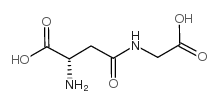Beta-天冬氨酰甘氨酸

Beta-天冬氨酰甘氨酸结构式

|
常用名 | Beta-天冬氨酰甘氨酸 | 英文名 | H-Asp(Gly-OH)-OH |
|---|---|---|---|---|
| CAS号 | 3790-52-1 | 分子量 | 190.15400 | |
| 密度 | 1.499 g/cm3 | 沸点 | 580.2ºC at 760 mmHg | |
| 分子式 | C6H10N2O5 | 熔点 | 160-168ºC | |
| MSDS | 美版 | 闪点 | 304.7ºC |
|
'Normalization' of germfree mice after direct and indirect contact with mice having a 'normal' intestinal microflora.
Lab. Anim. 20(4) , 286-90, (1986) Germfree mice were associated via direct and indirect contact with a 'normal' microflora by placing 'normal' mice in an isolator with germfree mice. Relative caecal weights, the ratio of secondary to primary bile acids, the presence of filamentous segmented b... |
|
|
Influence of zinc bacitracin and Bacillus licheniformis on microbial intestinal functions in weaned piglets.
Vet. Res. Commun. 27(7) , 513-26, (2003) The influence of zinc bacitracin (ZB) and of Bacillus licheniformis on host microbial-related functions in young piglets was investigated by applying the concept of microflora-associated characteristics. Six biochemical parameters were determined before and a... |
|
|
[Rapid diagnosis of dysbacteriosis by detecting beta-aspartylglycine in the feces in an experiment].
Zh. Mikrobiol. Epidemiol. Immunobiol. (8) , 15-8, (1985) In experiments on Fischer rats (F-344), both with common microflora and germ-free, the influence of the systemic destination of different antibiotics (tetracycline + ampicillin, gentamicin + kefzol, gentamicin, fradizine) on the intestinal microflora, the con... |
|
|
Effects of selective oral antimicrobial prophylaxis and systemic antibiotics on the fecal flora and fecal beta-aspartylglycine concentration in patients with acute leukemia.
APMIS 97(8) , 705-14, (1989) The influence of selective oral antimicrobial prophylaxis (SOAP) and systemic antibiotic treatment (SAT) on the intestinal flora of fourteen granulocytopenic patients was investigated. For SOAP, patients received Cotrimoxazole, Polymyxin and Nystatin; Gentami... |
|
|
[Changes in the microflora of the large intestine in rats administered cephalexin and erythromycin orally].
Antibiot. Med. Biotekhnol. 32(3) , 206-10, (1987) The effect of long-term use of cephalexin and erythromycin (for 17 days) on large intestine microflora was studied on rats. It was found that intragastric administration of cephalexin in a dose of 800 mg/kg and erythromycin in a dose of 400 mg/kg was followed... |
|
|
Identification of an acidic dipeptide, beta-aspartylglycine, in the CNS of Aplysia.
J. Neurochem. 43(5) , 1375-84, (1984) A novel dipeptide, beta-aspartylglycine (beta-DG), has been isolated from tissues of the marine gastropod mollusc Aplysia californica. This compound was detected only in Aplysia and not in other molluscs, such as Helix or Mercenaria, or in lobster or frog. Am... |
|
|
Influence of temocillin on colonisation resistance and consequences for therapy.
Drugs 29 Suppl 5 , 227-33, (1985) The influence of temocillin on the colonisation resistance of the digestive tract was studied in mice, with doses ranging from 0.062 to 1 mg/day administered orally and 0.25 to 4 mg/day administered subcutaneously. The effect on the colonisation resistance wa... |
|
|
Confirmation of D-aspartic acid in the novel dipeptide beta-aspartylglycine isolated from tissue extract of Aplysia kurodai.
Biochem. J. 263(2) , 617-20, (1989) A novel o-phthalaldehyde-reactive compound was found in the h.p.l.c. chromatogram of Aplysia kurodai extract. This compound was isolated by ion-exchange chromatography and preparative high-voltage paper electrophoresis. It was shown by optical-rotatory-disper... |
|
|
Synthesis of the novel dipeptide beta-aspartylglycine by Aplysia ganglia.
J. Neurochem. 45(3) , 983-6, (1985) Isolated ganglia from Aplysia californica rapidly took up [14C]glycine or [14C]aspartate from a sea-water medium. Approximately 20% of the tissue radioactivity was recovered in the peptides beta-aspartylglycine and glutathione after incubation with [14C]glyci... |
|
|
Selective decontamination of the digestive tract with aztreonam: a study of 10 healthy volunteers.
J. Infect. Dis. 150(5) , 636-42, (1984) Aztreonam, a minimally absorbable monobactam antibiotic that is active primarily against gram-negative bacilli, was given orally to 10 healthy volunteers in three regimens: 60 mg, 300 mg, and 1,500 mg daily for five days. The regimens were administered at lea... |